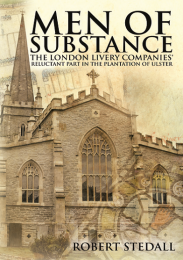Men of substance
Next » « PreviousA new book on the livery companies role in the Plantation of Ulster by Robert Stedall, a Past Master of the Ironmongers’ Company, has recently been published.
It was James I, who, in 1610, forced the London Livery Companies into colonising County Londonderry, then the most belligerent part of Ireland, and into fortifying Londonderry and Coleraine. He was looking for ‘Men of Substance’ to restore order among Ulster’s Irish chieftains, who were receiving Continental European support. Facing continuing attack from militant Ulster rebels, settlers did not arrive in sufficient numbers to establish control. Far from replacing the local Irish they needed their help to build their settlements. Charles I, frustrated at their failure to meet plantation objectives, expropriated their estates. This led to the City of London supporting Parliament in the Civil war, which cost Charles I his head. Meanwhile, in 1641, the Irish organised a concerted rebellion to destroy any remaining British settlements. It was only the walls of Londonderry, built by the City livery companies, which prevented them from re-establishing complete control.
 In his book MEN OF SUBSTANCE: The London Livery Companies’ Reluctant Part in the Plantation of Ulster, Robert Stedall explores the livery companies role in the Plantation from its beginnings in 1610 through to the 19th century when the Companies, realising their tenants’ plight, resumed control of their estates and commenced a period of rebuilding, development and community support. By 1900 though, most of the Companies had sold up, owing to the British Government’s policy of financing tenant purchases.
In his book MEN OF SUBSTANCE: The London Livery Companies’ Reluctant Part in the Plantation of Ulster, Robert Stedall explores the livery companies role in the Plantation from its beginnings in 1610 through to the 19th century when the Companies, realising their tenants’ plight, resumed control of their estates and commenced a period of rebuilding, development and community support. By 1900 though, most of the Companies had sold up, owing to the British Government’s policy of financing tenant purchases.
MEN OF SUBSTANCE: The London Livery Companies’ Reluctant Part in the Plantation of Ulster is published by Austin Macauley Publishers Ltd.
Interesting to notice the absence of religion in the above paragraphs. Further, the euphemisms of ‘Continental Europe’ [that seems to imply Europe from the Urals to Cabo da Roca, from Norway to Greece; and the term ‘local Irish’ leaves out the multiplicities of identities that historians would use for the peoples of Ireland in the period.